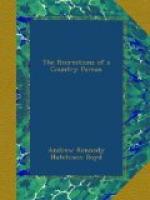And yet, although ‘death, and the house appointed for all living,’ form a topic which has been treated by innumerable writers, from the author of the book of Job to Mr. Dickens; and although the subject might well be vulgarized by having been, for many a day, the stock resort of every commonplace aimer at the pathetic; still the theme is one which never can grow old. And the experience and the heart of most men convert into touching eloquence even the poorest formula of set phrases about the tremendous Fact. Nor are we able to repress a strong interest in any account of the multitude of fashions in which the mortal part of man has been disposed of, after the great change has passed upon it. In a volume entitled God’s Acre, written by a lady, one Mrs. Stone, and published a year or two since, you may find a great amount of curious information upon such points: and after thinking of the various ways of burial described, I think you will return with a feeling of home and of relief to the quiet English country churchyard. I should think that the shocking and revolting description of the burning of the remains of Shelley, published by Mr. Trelawney, in his Last Days of Shelhy and Byron, will go far to destroy any probability of the introduction of cremation in this country, notwithstanding the ingenuity and the eloquence of the little treatise published about two years ago by a Member of the College of Surgeons, whose gist you will understand from its title, which is Burning the Dead; or, Urn-Sepulture Religiously, Socially, and Generally considered; with Suggestions for a Revival of the Practice, as a Sanitary Measure. The choice lies between burning and burying: and the latter being universally accepted in Britain, it remains that it be carried out in the way most decorous as regards the deceased, and most soothing to the feelings of surviving friends. Every one has seen burying-places of all conceivable kinds, and every one knows how prominent a feature they form in the English landscape. There is the dismal corner in the great city, surrounded by blackened walls, where scarce a blade of grass will grow, and where the whole thing is foul and pestilential. There is the ideal country churchyard, like that described by Gray, where the old elms and yews keep watch over the graves where successive generations of simple rustics




